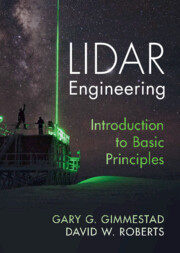Book contents
- Lidar Engineering
- Lidar Engineering
- Copyright page
- Dedication
- Contents
- Preface
- Glossary
- List of Abbreviations
- 1 Introduction
- 2 The Basic Lidar Models
- 3 The Molecular Atmosphere
- 4 Particles in the Atmosphere
- 5 Lidar Transmitters
- 6 Lidar Receivers and the Geometrical Function
- 7 Optomechanics
- 8 Optical Detection
- 9 Data Systems
- 10 Lidar Data Analysis
- 11 Applications
- Appendix A The Klett Retrieval
- Index
- References
8 - Optical Detection
Published online by Cambridge University Press: 16 February 2023
- Lidar Engineering
- Lidar Engineering
- Copyright page
- Dedication
- Contents
- Preface
- Glossary
- List of Abbreviations
- 1 Introduction
- 2 The Basic Lidar Models
- 3 The Molecular Atmosphere
- 4 Particles in the Atmosphere
- 5 Lidar Transmitters
- 6 Lidar Receivers and the Geometrical Function
- 7 Optomechanics
- 8 Optical Detection
- 9 Data Systems
- 10 Lidar Data Analysis
- 11 Applications
- Appendix A The Klett Retrieval
- Index
- References
Summary
This chapter begins with a brief review of electronic circuitry and terminology because optical detection and signal processing are in the realm of electrical engineering. A detailed discussion of analog detection follows, with circuitry including transimpedance amplifiers and equivalent circuits for analyzing noise and bandwidth. Two electronic noise sources are introduced, Johnson noise and amplifier noise, and their effects on SNR are modeled. Photon counting is then discussed in terms of its instrumentation, advantages, and limitations. The basic principles of coherent detection are elucidated through a mathematical derivation, and the advantages of coherent detection are shown: high SNR, optical background discrimination, and the measurement of Doppler shifts to sense winds. The main types of detectors used in lidar systems are then discussed, including intrinsic and PIN photodiodes, photomultipliers, avalanche photodiodes, and single-photon avalanche diodes. The advantages of internal detector gain for optimizing SNR are quantified.
Keywords
- Type
- Chapter
- Information
- Lidar EngineeringIntroduction to Basic Principles, pp. 204 - 245Publisher: Cambridge University PressPrint publication year: 2023

